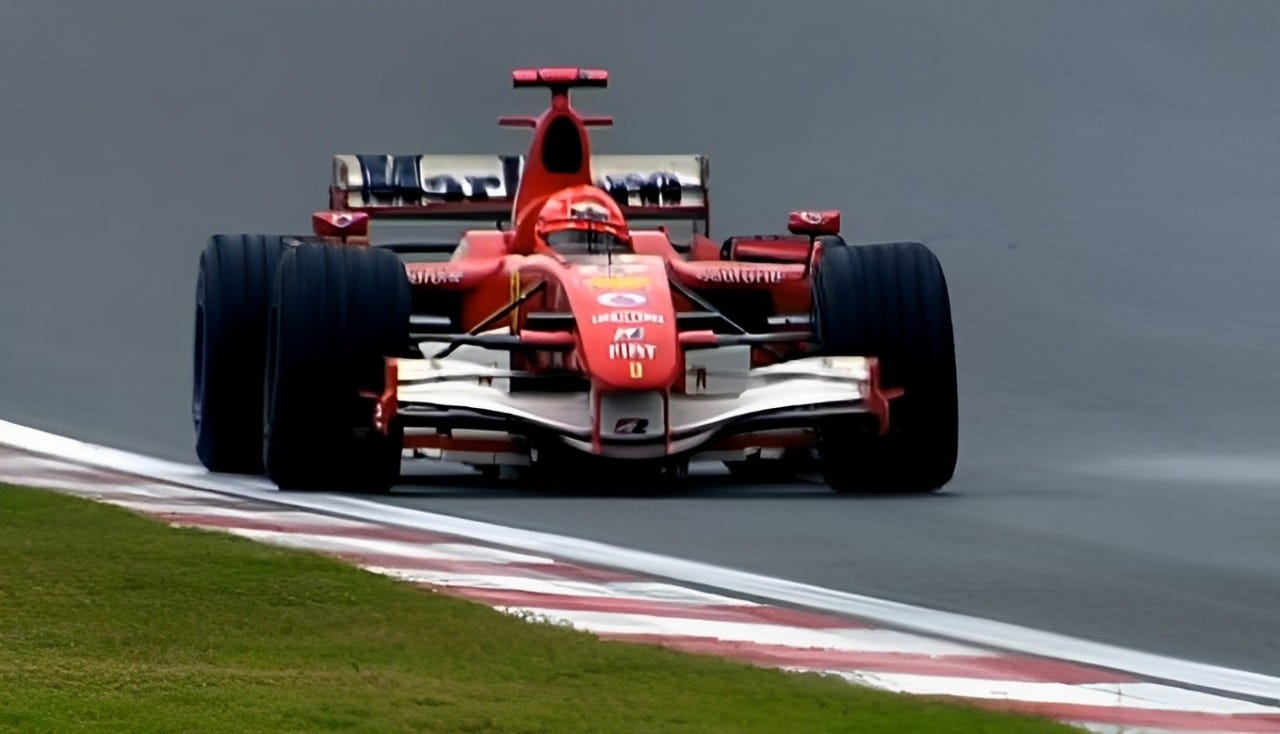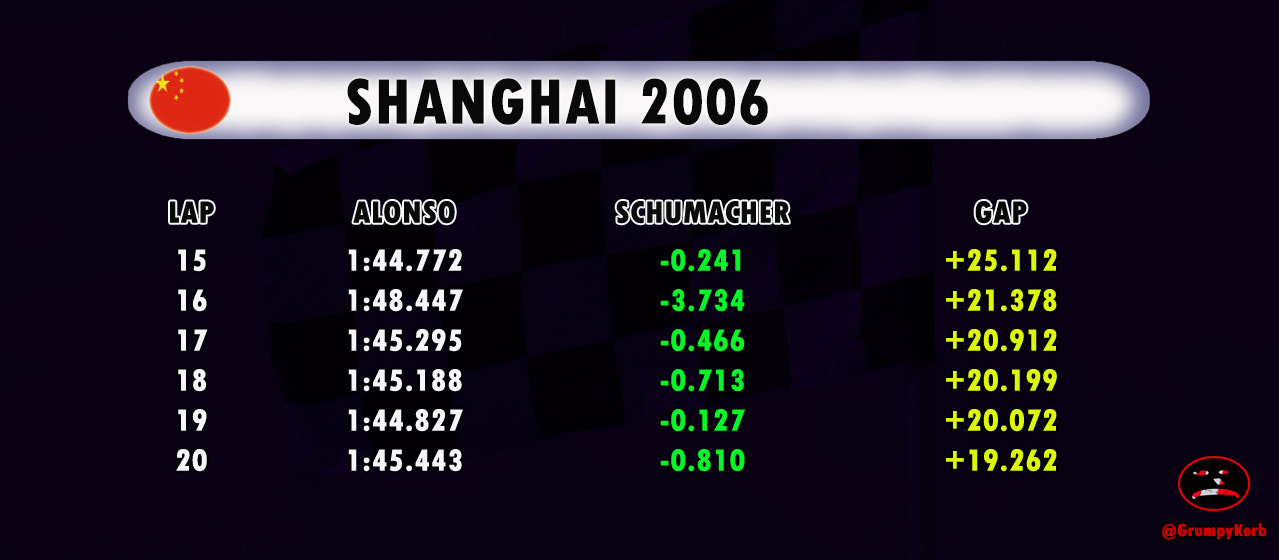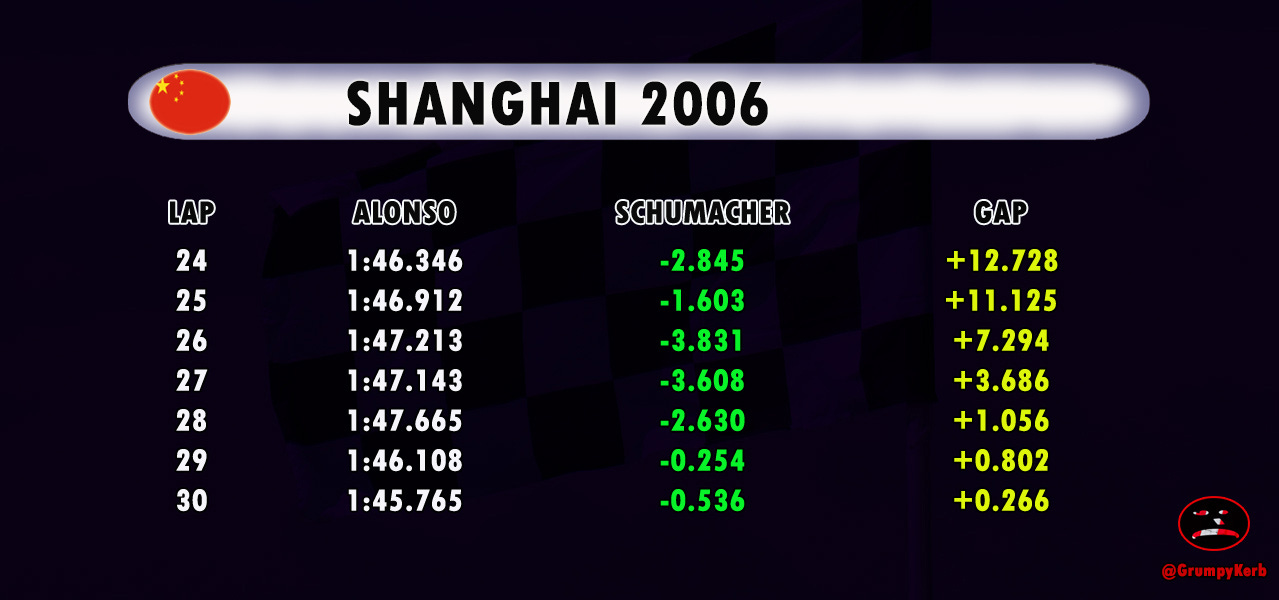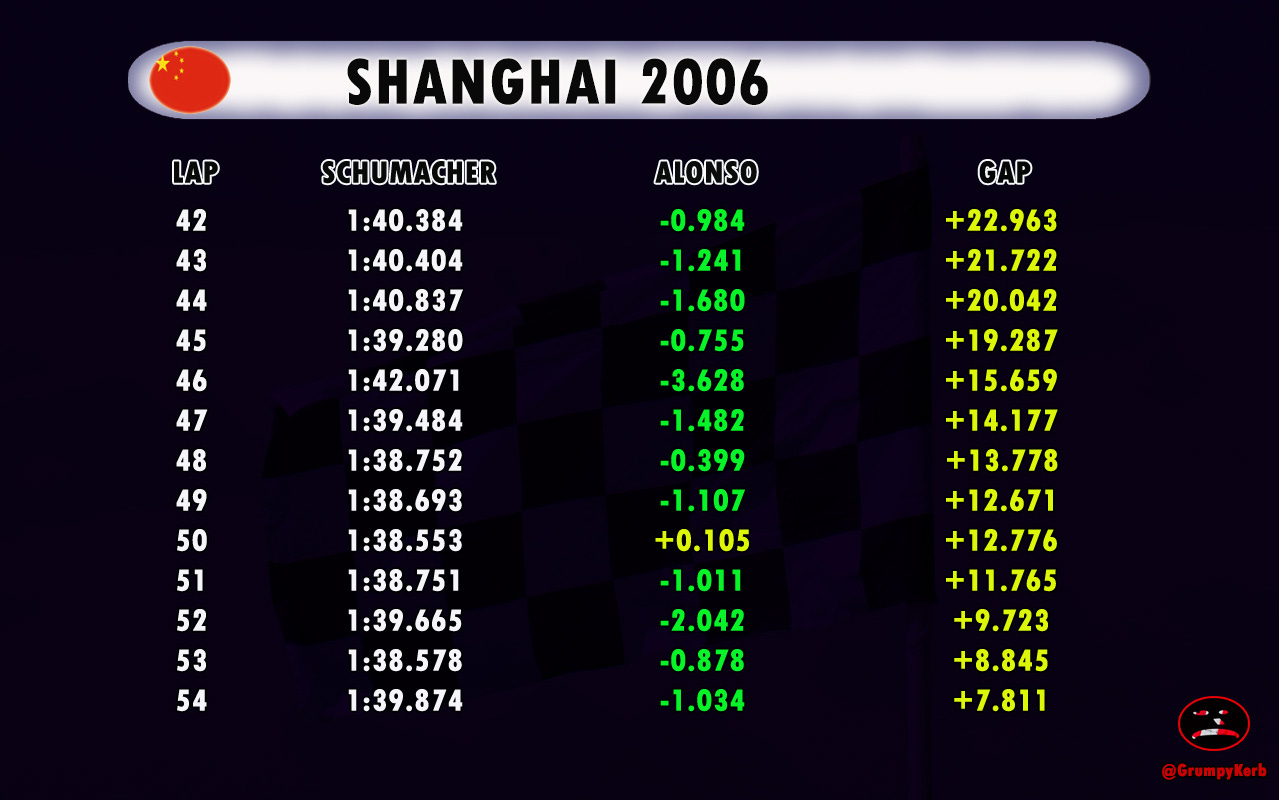The eras in Formula 1 are often defined by regulations. The rules change cyclically, resulting in different specifications for the cars that teams and drivers must adapt to.
The period from 2006 to 2013 is commonly referred to as the V8 era. The name, of course, derives from the type of engines that powered Formula 1 cars during those 8 years. I believe it is not a controversial statement to assert that this was the most competitive period of the sport in the ongoing century. Five out of the eight the championship went to the last race, one was clinched in the penultimate round, and only on two occasions was the title was decided sooner. Only one driver, Sebastian Vettel, was able to repeat. He did it three times, but only two of his titles were won with relative ease.
Emperor Shanghai
The aforementioned period of screaming, naturally aspirated engines coincided with the reign of Emperor Shanghai. That’s how I’ve called the 5.5-kilometer-long circuit located in East China. Because it delivered big time. The races held in 2006, 2007, 2009, 2010, 2011, and 2013 ranged from very good to all-time great. No other circuit during that period boasted such an impressive record. Therefore, I have always thought that Emperor is an appropriate nickname. And I’m glad to see the circuit back on the calendar.
The 2006 Championship Fight
Let’s go back in time to the first race mentioned in the paragraph above, marking the inauguration of Emperor Shanghai’s reign. The year is 2006, the inaugural season of the current Q1-Q2-Q3 qualifying format and V8 engines, as well as the final season featuring two tire suppliers: Michelin and Bridgestone, who produce ugly grooved dry tires mandated by the FIA. This year also signifies the last season of the Todt-Brawn-Schumacher triumvirate at Ferrari. By the end of the year, the German retired and the Englishman chose to take a one-year sabbatical. The Frenchman stayed for one more season.
The cars had traction and launch control, and the strategies still revolved around refueling. The former will be banned starting in 2008, and the latter from 2010. The points system is 10–8–6–5–4–3–2–1 and the two championship protagonists, the Renault driver Fernando Alonso and his Ferrari counterpart Michael Schumacher, are separated by only 2.
The first part of the season belonged to Reanult, but after the FIA banned their mass damper on safety grounds, momentum shifted towards Ferrari. The 25-point lead that Alonso had enjoyed after Canada almost completely evaporated following the race at Monza, where the Spaniard suffered engine failure. Schumacher won the event and announced that he would be retiring at the end of the season. The number one question was: Will Schumacher finish his career with eight championships, or will Alonso secure his second?
With three races remaining, the German seemed to be the favorite. Overall, Ferrari outperformed Renault in the second part of the season, with the exception of specific atmospheric conditions. These conditions influenced both qualifying and the race in Shanghai, where it rained on both Saturday and Sunday. The intermediates were the name of the game.
Bridgestone vs. Michelin
In 2006, Michelin produced much better specification of the aforementioned tire. Schumacher was painfully aware of this fact in Hungary. In the race he was nowhere compared to the majority of Michelin runners. The rainmaster had a dismal performance in the wet.
So, he was likely not overjoyed when it rained during the qualifying session for the third Chinese Grand Prix, where he finished 6th. Truth to be told third row was a good result under those conditions, especially considering that no other Bridgestone runner made it to Q3. Alonso secured pole position, the first for him since Canada, six races prior. The combination of his driving skills, the Renault car, and Michelin intermediates proved to be more effective than anything else on that rainy Saturday.
The credit for securing 6th place, aside from Schumacher’s trademark prowess in the wet, has to be given to the Japanese tire supplier for improving their compound — the benefits of in season testing that ultimately banned in 2009. Bridgestone inters were still lagged behind Michelin, the disparity was not as staggering as it had been in Hungary.
The Start
One interesting aspect of the starting grid for the third Chinese Grand Prix was that every driver in the top six: Fernando Alonso, Giancarlo Fisichella, Rubens Barrichello, Jenson Button, Kimi Raikkonen and Michael Schumacher, had a race victory to their name. The most recent winner was Button, who had won in Hungary. The other members of this exclusive group included David Coulthard, Felipe Massa, who, like Button, achieved his maiden victory in 2006, and both Toyota drivers: Jarno Trulli and Schumacher’s little brother Ralf.
There were two race-winning drivers missing from the grid. The first was Jacques Villeneuve. Starting from Hungary, the Canadian was replaced by Robert Kubica at BMW Sauber. The Polish rookie quickly made a name for himself by scoring a podium at Monza, in his third race in Formula 1. Juan Pablo Montoya was the other race-winning driver who had departed from the sport. Pedro de la Rosa filled his place at McLaren.
On October 1, 2006, twenty-two cars filled their grid slots for the third Chinese Grand Prix. The track was damp, with a light drizzle, but there weren’t many puddles on the tarmac. The conditions were ideal for inters and sets of these tires were fitted on every car.
The engines roared like predators defending their territory as the five red lights went off, the clutches were dropped and the roosters of spray erupted. The two Renault drivers, Alonso and Fisichella started well and maintained their positions. The Honda duo behind them lost ground to Raikkonen on the opening lap. The McLaren driver overtook Barrichello around the outside of the first corner and nearly passed Button, who had overtaken his teammate on the inside. The Englishman successfully defended against two overtaking attempts from the Finn, but ultimately had to concede on the back straight. Schumacher retained 6th place. At the end of the first lap, he was approximately 6.5 seconds behind the race leader.
Schumacher on the Move, Raikkonen’s Futile Effort
The gap continued to widen. Alonso, the only driver with a clear track ahead, was effortlessly leaving everyone behind. Meanwhile, his championship rival, trapped in the spray from Barrichello’s Honda, could only hope for an opportunity to pass. The chance arose on the 8th lap. Barrichello defended the inside line at the end of the back straight had a slight oversteer on the exit of the hairpin. Schumacher went for a switchback and got his former teammate around the outside of the final corner.
The German made a good use of the clean air and picked up the pace. Previously, he had been losing an average of 2 seconds per lap to Alonso. Now, that deficit was reduced to only 0.6 seconds. The Ferrari driver quickly caught up to Button and overtook him with ease on the back straight on lap 14. He now held 4th place, 25 seconds behind the leader.
Raikkonen was also charging, partially thanks to a lighter fuel load. He overtook Fisichella for a 2nd place. Unfortunately for the Finn, his moment of glory was short-lived. He pitted on lap 16 and retired two laps later due to a throttle issue.
Once Schumacher passed Button for the first time in the race, he set a pace faster than Alonso's. Before pitting, he reduced the gap between himself and the leader to 19 seconds.
Alonso helped his championship rival by going off track in the first corner on the 16th lap. Thanks to that mistake, Schumacher gained almost 4 seconds.
The Tire Mix Up
The German caught up to the second Renault on the track before diving into the pits on lap 20. The Ferrari crew refueled his car and left worn inters on. Same story with Fisichella, who pitted three laps later. Alonso boxed in between his teammate and his championship rival. Renault, which had suffered temporary power outage on their pit wall before servicing their driver, fitted two new intermediates on the front of his car and left used ones on the rear. I’m not sure about the current F1, but in 2006, that was permissible.
Why did Renault change the front tires? At the end of the race, Ted Kravitz said that the team had done this because the fronts had been heavily worn. Frankly, whenever Kravitz says anything my default position is to press doubt, but here I must concede that he was likely correct.
Before the aforementioned mistake, Alonso had been setting high 44’s, but after going off track, his pace dropped to low 45’s. Meanwhile Fisichella, Schumacher, and nearly every other driver on the circuit were going faster than before, due to improving conditions and the cars becoming lighter as they burned fuel. It indeed appears that the Spaniard did not adequately manage the front tires.
Kubica’s Bravery
Speaking about rubber, the first brave to put dry tires was the rookie Kubica. The BMW Sauber driver made the change on lap 24, after previously executing some eye-catching overtakes and setting the fastest lap at 1:42.072.
The track continued to improve and was very kind to worn intermediates, but not to dry tires. Kubica was quickly and embarrassingly made aware of this fact. After exploring the run-off areas of the Shanghai circuit, he returned to the pits for the worn inters so favored by the capricious conditions.
Alonso Struggles
Meanwhile, Alonso found himself in big trouble. The worn-fresh tire mix-up on his car wasn’t working. Already on his out lap, he lost approximately 3.5 seconds compared to Schumacher’s first lap after exiting the pits. The Spaniard, on an improving track, was slower than during his first stint in worse conditions. The German, now 3rd on the track with only Fisichella between him and Alonso, immediately took advantage of the vulnerable leader.
The 19-second advantage that Alonso had enjoyed before the pit stop was reduced to just 1 second by lap 28. His teammate was 0.4 seconds behind. Fisichella attempted to protect the Spaniard by overtaking him and then relinquishing the position at the end of the back straight, but ultimately passed him on lap 30.
At this point, Alonso was nothing more than a sitting duck. He offered little resistance when Schumacher executed his maneuver in Turns 3 and 4 on lap 31. Their duel resembled a race between a small sailboat and a raft, with a survivor rowing it with his bare hands.
Schumacher, now 2nd went after Fisichella. The Italian briefly pulled away from the scarlet Ferrari, establishing a 2.5-second lead, but not for long. Schumacher closed the gap and, in the process, he set the fastest lap at 1:40.997, previously held by the new race leader. For several laps, the distance between the two fluctuated within 1 second.
Heavily compromised, Alonso was losing time to the leaders. 4 laps after Schumacher overtook him, the gap between Alonso and his championship rival increased to around 7.8 seconds. The Spaniard had no choice but to endure the punishment and extend his stint until the track was ready for dry tires.
He pitted on lap 35 and received a fresh set of Michelins. However, the pit stop was far from smooth; the mechanics encountered difficulties with the right rear wheel, which cost their driver a lot of time. (More on that later.)
Alonso emerged 53 seconds behind the leader, in 6th place, but quickly advanced two positions when de la Rosa and Barrichello pitted. He had only Heidfeld and approximately 3 kilometers of clear air separating him from the leading duo. He outpaced them during his first two flying laps.
The Maranello Undercut
This fact lighted a bulb in Ross Brawn’d mind, prompting the master strategist to immediately call his boy into the pits. Schumacher got a set of dry Brigdestones on lap 40 and went for it. Renault responded by bringing Fisichella in on the following lap.
When the Italian emerged from the pits, his advantage over Schumacher visually, appeared to be greater than before. After all, bringing the necessary temperature in new dry tires on a semi-damp track is a rather demanding task.
Fisichella experienced this firsthand, particularly in the first corner. The Renault veered off the dry line and went wide, allowing Schumacher to capitalize on the opportunity. He stormed through the gap like a bullet, clinging to the apex of the first corner. In fact, he even placed his right front wheel on the grass to avoid contact with Fisichella as the Italian rejoined the racing line, successfully making the pass. Schumacher then pulled away from the Renault driver, taking the lead with 14 laps remaining.
Alonso Fights Back
One guy who certainly wasn’t impressed by Schumacher’s speed was Alonso. He was 3rd on lap 42 after Heidfeld had pitted. He had plenty of pace and plenty to fight for. And he was the fastest man on the track. Way faster than the leader.
Alonso set 8 consecutive purple laps (from lap 42 to 49), with the last one being 1:37.586, which ultimately ended up being the fastest lap of the race. While pursuing his championship rival, he overtook Fisichella, who, of course let him by.
Remember what I wrote earlier about a small sailboat and a raft? The roles now reversed. Almost. Because Schumacher definitely wasn’t struggling. The 3.5 seconds he lost on lap 46 were due to lapping slower cars. I wonder if one of those backmarkers was Takuma Sato, as the Japanese driver was disqualified from this race for ignoring blue flags.
Alonso, during his out lap on dry tires, lost 18 seconds compared to Schumacher’s out lap due to the previously mentioned issues with the right rear tire. The German exited the pits approximately 24 seconds ahead of the Spaniard. Simple math indicates that the championship rivals would have been separated by just 6 seconds had there been no problems during Alonso’s pit stop.
With only 6 seconds between them, 15 laps remaining, and huge pace advantage, the Renault driver over his Ferrari counterpart, would Schumacher have been able to fend off Alonso? Would the pace advantage have been sufficient to counteract the dirty air, which was likely at its worst in this century? We can only speculate, but if I were a betting man, I would put my money on the guy in the blue Renault.
There are moments in Formula 1 that, once witnessed, become instantly memorable. The moments that generate intense emotional response, electrify guts and carve their shape in human memory like a marble sculptor. One such moment, at least for me, occurred during this race when Fernando Alonso twitched the steering wheel left and right on the main straight, causing the car to jitter. I cannot rationally explain it, but for me, it stands out as one of those iconic moments.
With two laps remaining, Alonso closed the gap to 7.8 seconds. Then, the weather decided to spice things up. It started raining again, causing lap times to slow by four seconds. However, it was too late for the rain to make any difference. Well, almost.
Button Pushes Through
On the final lap, Button, typically a juggernaut in mixed conditions, gained two places at the expense of his teammate Barrichello and the sole McLaren of Pedro de la Rosa, finishing as the best of the rest — the maximum he could achieve. Heidfeld and Webber were the last drivers to score points.
The Rays of the Setting Sun
Schumacher took it easy and let Alonso get even closer. The difference at the finish line was 3 seconds, which is quite remarkable considering that at one point, the Spaniard was leading his rival by 25 seconds, to later fall net 24 behind and get so close at the end. The race must’ve been a nerve wrecking roller coaster for Alonso.
As for Schumacher, it was one of his finest victories. He started from the third row, drove a strategic race, executed crucial overtakes, and capitalized on every opportunity, as well as the mistakes and misfortunes of his rivals. All of this was accomplished in a car that was not as well-suited for the conditions as the Renaults.
The sun, known as Schumacher, had descended from its zenith and entered the setting phase. But before it disappeared behind the horizon, it gave us something nice to look at.







